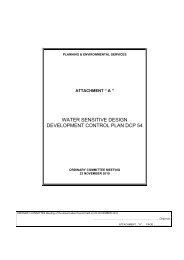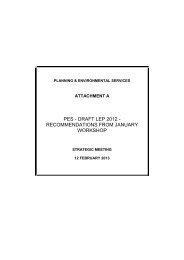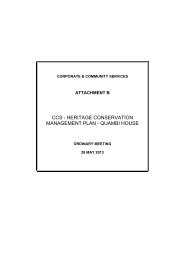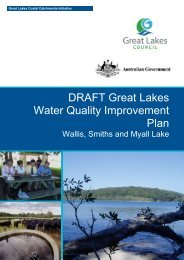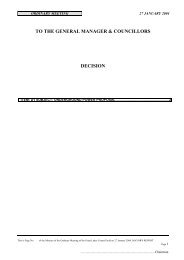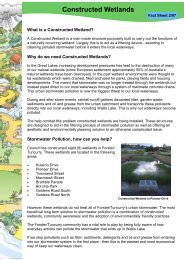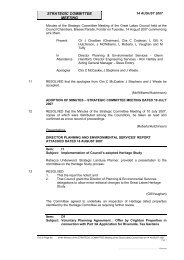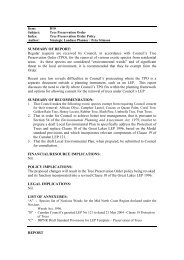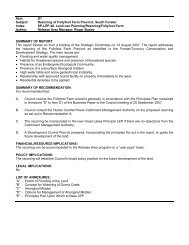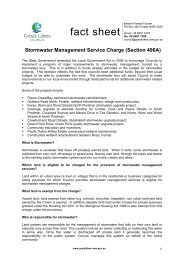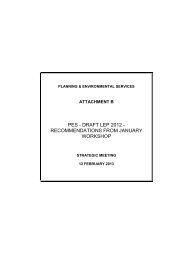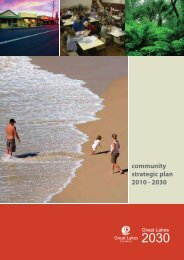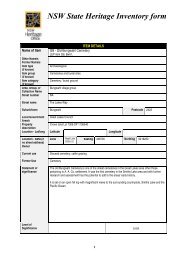13.2 The Wallis Lake Estuary Management Committee - Great Lakes ...
13.2 The Wallis Lake Estuary Management Committee - Great Lakes ...
13.2 The Wallis Lake Estuary Management Committee - Great Lakes ...
Create successful ePaper yourself
Turn your PDF publications into a flip-book with our unique Google optimized e-Paper software.
<strong>Wallis</strong> <strong>Lake</strong> <strong>Estuary</strong> <strong>Management</strong> Plan<br />
E.6<br />
<strong>Management</strong> Area A, B, C, D, E, F<br />
<strong>Management</strong> Objective<br />
Protect and enhance riparian vegetation<br />
Action<br />
No<br />
Action<br />
Indicative<br />
Cost<br />
E.6.1 Employ a river keeper or other paid worker to maintain and restore vegetation in $80,000<br />
riparian zones<br />
per year<br />
E.6.2 Conduct a riparian vegetation assessment $20,000 +<br />
staff time<br />
E.6.3<br />
E.6.4<br />
E.6.5<br />
Concentrate revegetation and restoration efforts in priority areas identified in the<br />
riparian vegetation assessment<br />
Develop and execute a control program for weeds of national significance<br />
including Ground and Climbing Asparagus, Mother of Millions, Lantana, African<br />
Boxthorn, Pampas Grass, Bridal Creeper and Bitou Bush on Cut, Bells, Mathers,<br />
Long, Cockatoo, Oaky and Godwins Islands<br />
Monitor and enforce compliance with SEPP 14, the Native Vegetation Act and<br />
tree preservation orders to reduce the incidence of illegal clearing of foreshore<br />
vegetation<br />
$50,000 +<br />
staff time<br />
$10,000<br />
per year<br />
Priority Responsibilities Progress<br />
Immediate (A3)<br />
High (B3)<br />
High (B3)<br />
High (C3)<br />
GLC, DIPNR,<br />
Waterways<br />
GLC, DIPNR,<br />
Waterways,<br />
Lands<br />
GLC, DIPNR,<br />
Waterways,<br />
Lands, Landcare<br />
Lands, GLC<br />
Staff time High (D2) GLC + DIPNR Ongoing<br />
E.6.6 Continue to provide technical support and training to local Landcare groups $50,000 Medium (B5) CMA Ongoing<br />
per year<br />
Comments<br />
<strong>The</strong>re is a very real need for a paid worker to coordinate revegetation and weed control efforts in riparian zones. At present community groups almost solely conduct the<br />
maintenance of riparian zone habitats. An employed river keeper or other paid worker would be responsible for coordinating efforts to remove environmental and noxious weeds<br />
from foreshore areas and adjacent bushland of rivers and islands. Effective control of these weeds requires a minimum of 20 hrs manual labour per hectare twice per year plus<br />
costs associated with transport to and from the islands and appropriate chemicals. If the person employed was a river keeper (a joint Waterways initiative), peak periods would be<br />
spent on the water in <strong>Wallis</strong> <strong>Lake</strong> enforcing boating-related legislation.<br />
<strong>The</strong> results of the riparian vegetation assessment should be included in the foreshore management plan for the <strong>Wallis</strong> <strong>Lake</strong> foreshores and estuarine islands. <strong>The</strong> assessment<br />
should also ensure identify areas where riparian zone wildlife transport corridors have been compromised and areas in need of revegetation/restoration.<br />
Public reserve areas experiencing considerable illegal clearing are Muddy Creek, Coomba Park, Forster Keys and Pipers Bay. However it is acknowledged that most reserves<br />
experience this to some degree. <strong>The</strong> main reasons that this is occurring are to increase/maintain views and gain direct access to the waterway. Regular monitoring and education<br />
through strategy C.3 will contribute to reducing the occurrence of illegal clearing in reserve areas.<br />
48




